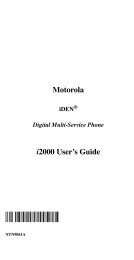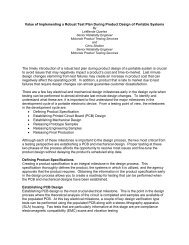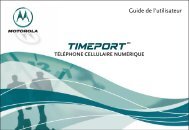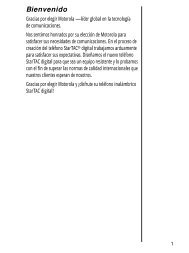T193 - Telefonguru
T193 - Telefonguru
T193 - Telefonguru
Create successful ePaper yourself
Turn your PDF publications into a flip-book with our unique Google optimized e-Paper software.
17 add’l safety info<br />
50<br />
glioma (a type of brain cancer) or acoustic neuroma (a<br />
benign tumor of the nerve sheath). No statistically significant<br />
association was found between mobile phone use and<br />
acoustic neuroma. There was also no association between<br />
mobile phone use and gliomas when all types of types of<br />
gliomas were considered together. It should be noted that<br />
the average length of mobile phone exposure in this study<br />
was less than three years.<br />
When 20 types of glioma were considered separately,<br />
however, an association was found between mobile phone<br />
use and one rare type of glioma, neuroepithelliomatous<br />
tumors. It is possible with multiple comparisons of the same<br />
sample that this association occurred by chance. Moreover,<br />
the risk did not increase with how often the mobile phone<br />
was used, or the length of the calls. In fact, the risk actually<br />
decreased with cumulative hours of mobile phone use. Most<br />
cancer causing agents increase risk with increased exposure.<br />
An ongoing study of brain cancers by the National Cancer<br />
Institute is expected to bear on the accuracy and<br />
repeatability of these results. 1<br />
b Researchers conducted a large battery of laboratory tests to<br />
assess the effects of exposure to mobile phone RF on genetic<br />
material. These included tests for several kinds of<br />
abnormalities, including mutations, chromosomal<br />
aberrations, DNA strand breaks, and structural changes in<br />
the genetic material of blood cells called lymphocytes. None<br />
of the tests showed any effect of the RF except for the<br />
micronucleus assay, which detects structural effects on the<br />
genetic material. The cells in this assay showed changes after<br />
exposure to simulated cell phone radiation, but only after 24<br />
hours of exposure. It is possible that exposing the test cells to<br />
radiation for this long resulted in heating. Since this assay is<br />
known to be sensitive to heating, heat alone could have<br />
caused the abnormalities to occur. The data already in the<br />
literature on the response of the micronucleus assay to RF<br />
are conflicting. Thus, follow-up research is necessary. 2<br />
FDA is currently working with government, industry, and<br />
academic groups to ensure the proper follow-up to these<br />
industry-funded research findings. Collaboration with the










